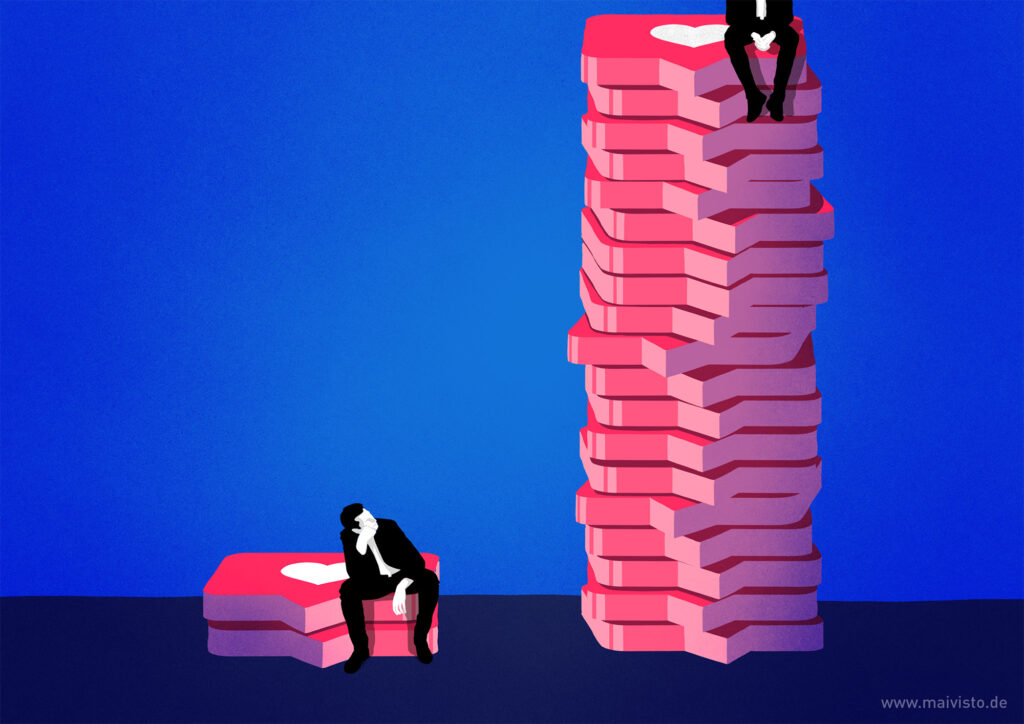
Let’s face the truth. There are countless artists, illustrators, designers, musicians, and writers out there. Just take a look at Instagram or Youtube. We are inundated with people and fantastic talents working in the same field and who are more successful than we are. Each one has his own story, vision, views, and skills. But part of the truth is that countless clients worldwide are willing to work with us. There are enough opportunities for all of us.
The feeling of envy can sometimes flare-up
Now we are free to choose how we view these competitors. Do we see them as rivals whom we have to outcompete at any cost to survive? Or as colleagues who actually support each other along the way?
The feeling of envy can sometimes flare-up. For example, when people in the same industry as us have thousands of followers on Instagram, work for clients like Google and Coca-Cola, and jet around the world giving talks in front of hundreds of people. On the other hand, we barely get beyond 100 followers and our four walls, and our only clients are our favorite aunt and the bakery next door.
They are, after all, living proof that it is possible to achieve our goals
Let’s send our egos out of the room for a moment, though, and let’s celebrate our colleague’s success. They are, after all, living proof that it is possible to achieve our goals.
What we can do now is learn from them. Let’s analyze how they did it. What does their homepage look like? How and which works do they present there? How do they act and react on social networks? Do they offer courses, write books, or a blog? All this valuable information can be used by us, and the best thing is that it’s only one free click away.
In addition, there is the possibility of trying to get in touch with them. Usually, colleagues like to help each other and give feedback on work or congratulate on an outstanding success.
When I started, there were a handful of illustrators I admired and still do. One of them is by the name of Antonio. His diverse work is fascinating, reflected in the number of followers on his social networks. I also followed him on various platforms. One of them is Behance, an international network to present creative works.
Some time ago, there was a Work-in-progress section on the platform where users could share intermediate steps of their work and ask for feedback. Antonio also shared a current project there and asked for feedback. Despite thousands of followers, the feedback on his designed double page for a magazine remained relatively low.
The reactions to my projects increased, putting me and my work on the radar of other users and potential clients
In the design he worked on, I noticed that one page seemed a bit overloaded and suggested he might try moving the bottom text block to the other side. Antonio was pleased with the hint, as he told me that he had this thought as well but wasn’t sure about it. So he adjusted his design. After a brief exchange, he took the time to look at some of my projects on Behance, commenting and liking them. As his followers saw his activity, the views and the reactions to my projects automatically increased, putting me and my work on the radar of other users and potential clients. So there was no competitiveness at all. We were simply colleagues who helped each other.
Another example: A few years ago, the Lürzer’s Archive – Best of Illustration selected my submission and planned to publish my work in their annual issue. As with most high-profile competitions, participation comes with fees that would have severely stretched my bank balance at the time.
Jens is a conceptual illustrator whose work I have been following for a long time. He was also honored by the Lürzers Archive in a past issue. One morning I picked up the phone, dialed his number, and asked if he could share his experience with me. I was nervous because, after all, he could have been annoyed by my request for advice. I began the conversation by complimenting him on his work and giving an honest explanation of why I found his work so impressive. To my relief, he replied, “That’s a great way to start the day. Thanks. We had a relaxed conversation, and he shared valuable insights that eventually convinced me to invest the money.
A win-win situation for everyone involved
Again, there was no hint of competitiveness but help. Good colleagues do just that. They support each other, share their concerns, and aren’t afraid to reveal their secrets. We can even go a step further and become partners in crime. For example, suppose I receive a request that I have to turn down for time or stylistic reasons. In that case, I can refer the client to another illustrator who might also be suitable for the job.
This can be a win-win situation for everyone involved: I want or need to turn down the job, the client gets new info in his search for a suitable illustrator, and a colleague is happy about a new inquiry and a potential job. Who knows what will result from such constellations in the future.